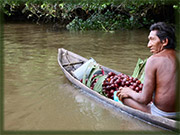
The Orinoco River Delta
The Orinoco River Delta, only one oceanic delta in the world, is a vast region of nearly 30,000 km² mainly composed by two major waterways or caños: caño Manamo, going to the north, and Rio Grande, which goes to the east, streaked by nameless of other channels, many of them navigable with large boats, others only with small canoes. It is located in Delta Amacuro State (40,200 km²) northeast of Venezuela.
Its topography is mostly flat, the temperature oscillates between 23°C and 32°C, the precipitation is abundant (between 900 and 2,500 mm per year) and there are flooded large forest areas.
The rich vegetation is composed, among others, by extensive mangrove communities and a large variety of palms, such as La Manaca and El Moriche, this last intensively used by the original inhabitants of the Orinoco delta, the Warao people.
The Warao, people of the Orinoco Delta
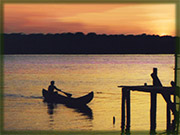
Warao, a word that means in their own language "People of canoes", after their lifelong and intimate connection to the water, are a peaceful and friendly tribe whose culture dates from about 8,500 years ago. They live mainly by hunting, fishing and gathering wild fruits, likewise, in some areas, planting bananas, plantains, manioc and others.
The Warao live only in Delta Amacuro State and surrounding areas, build their Palafitos (wall-less thatched-roof huts built upon stilts) along the banks of the channels and move mainly in canoes.
The Warao community, currently, has a population of approximately 36,000 persons, being the second largest native ethnic group of Venezuela, just after the Wayúu, to the west of the country.
Orinoco Delta wildlife
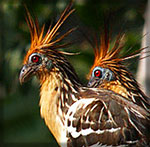
Among the Orinoco Delta Animal variety, we can name some mammals such as Sloths, Howler monkeys, Capuchin monkeys, Tapirs, Opossums, Jaguars, Ocelots, Giant otters, River dolphins, Orinoco Pink dolphins, etc.
Also a large variety of birds, being the most common: Macaws, several species of Toucans, Parrots, Chenchena or Hoatzin, harpy Eagle, Vultures, Hummingbirds, etc.
The Orinoco river delta is also the habitat of a large number of fish species: Piranha, Tarpon, Morocoto (herbivore piranha), more than 10 types of Catfishes and others.
Also we can find the Baba (spectacled caiman), the Anaconda, river turtles, iguanas, thousands of species of insects, spiders, butterflies, etc., etc., etc.
The Orinoco River
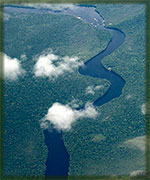
The Orinoco River covers a distance of 2,140 km, from Sierra Parima in southern Venezuela, until reaching the Atlantic Ocean through its delta, in the northeast of the country. Is one of the largest rivers in the world and the third in discharge, only surpassed by the Amazon and the Congo, with an average of 33,000 m³ of water per second into the ocean.
Its course draws annually 100 millions cubic meters of sediments, sand, silt and sandy clay, forming new soils to this way, in a distant future, join Trinidad island to the mainland.
The Orinoco Basin
The Orinoco Basin, also called Orinoquia, covers 70% of Venezuelan territory (880,000 km²) and it is 90% of freshwater reserves of the country. Almost all flora and fauna of Venezuela are represented in the Orinoco river basin, between its limits live 57 different types of forests, 2,600 species of vertebrates and more than 500,000 invertebrates.
When to visit the Orinoco Delta?
To visit the Orinoco Delta, any time of the year is good, however it’s opportune to note that with the onset of the rainy season (May-June), there is a little more mosquitoes than usually, this will not be a problem if we take some precautions like wearing long pants and a light shirt with long sleeves, and we protect ourselves with enough insect repellent.
What to do in the Orinoco Delta?
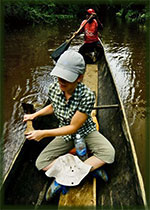
Live an unforgettable experience in the heart of the Orinoco delta jungle: navigate and explore its channels or waterways, discover its flora and fauna variety, meet and feel the touch of the millennial culture of its original inhabitants, the Warao. Finally, enter in an ecosystem where man and his environment have evolved in their minimum form.
We offer you several programs adapted to your possibilities and time during which you may, among others, fish piranhas, visit Warao settlements, explore narrow channels using a warao dugout canoe, adventure in jungle walks, nocturnal wildlife searches, besides lodging in a comfortable camp, entirely built of trunks and palms to the warao indigenous style.
Fore more information, please contact us







